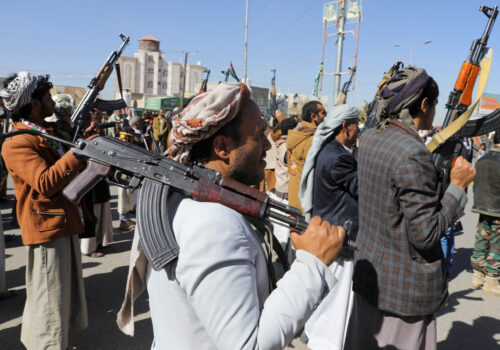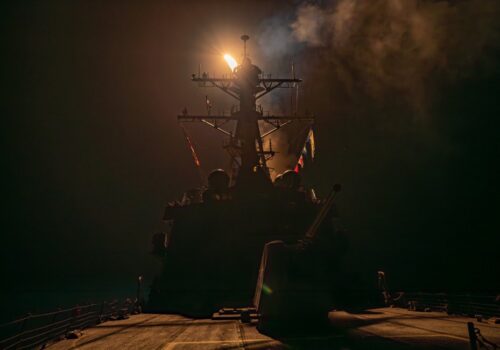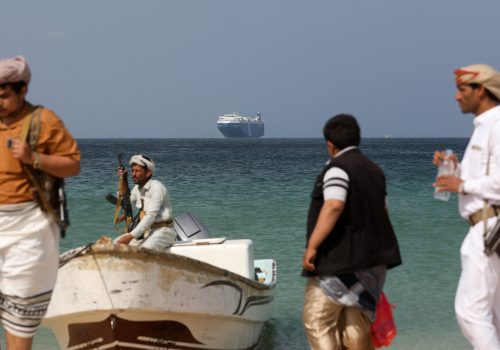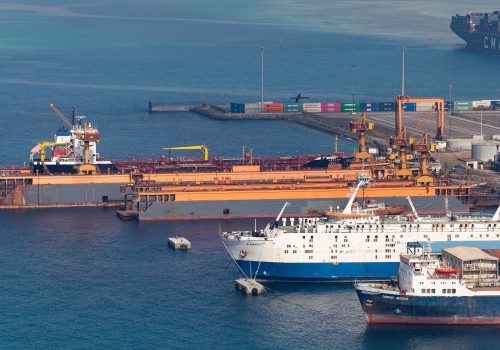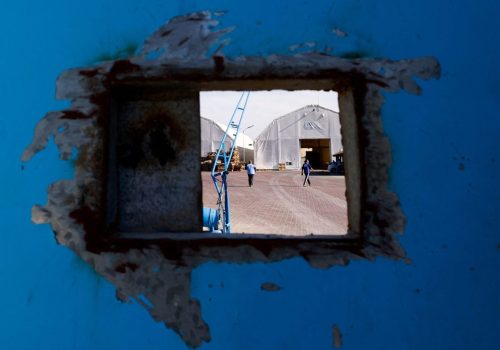Experts react: What to know about US and UK strikes on the Houthis in Yemen
Consequences were promised . . . and delivered. Last month, the United States formed a coalition of more than twenty nations called Operation Prosperity Guardian to respond to Houthi attacks on ships in the Red Sea. Last week, the United States, along with allies and partners, issued a stark warning to the Houthis to stop their aggression or face repercussions. Then, following another attack on shipping lanes on Tuesday, US and UK forces launched air and missile strikes on Thursday against dozens of Houthi targets in Yemen.
Below, Atlantic Council experts share their views on what to know about the strikes and what to expect next—including the prospects of a regional war with Houthi-backer Iran.
Click to jump to an expert analysis:
William F. Wechsler: The lessons Washington needs to learn from the strike
Daniel E. Mouton: Are the US and its allies willing to conduct additional strikes?
Kirsten Fontenrose: US-led strikes reflect the Houthis’ grave miscalculation
Jonathan Panikoff: From Iran to Saudi Arabia, the strikes will cause regional reverberations
Ellen R. Wald: Houthi attacks on freedom of navigation in the Red Sea demanded a direct response
Alex Plitsas: Iran’s proxies are only a symptom of a larger disease
The lessons Washington needs to learn from the strike
US President Joe Biden should be applauded for Thursday’s strikes against the Houthis. International trade is constrained by eight primary maritime chokepoints, hard realities imposed by immutable geography. The United States has long recognized a vital national security interest in ensuring freedom of navigation through each of them. This strike helped protect those interests.
Half of these eight global chokepoints are dispersed widely. Only one each can be found in Europe (the Strait of Gibraltar), in Africa (the Cape of Good Hope), in East Asia (the Straits of Malacca), and in the Americas (the Panama Canal). Unfortunately, the other half of these critical chokepoints are all concentrated in a relatively small region where southwestern Asia meets Europe and Africa: the Bosporus Strait, the Suez Canal, the Bab-el-Mandeb Strait, and the Strait of Hormuz. This area also happens to be the most important single source of the energy required to sustain global economic growth. Those two facts explain why US presidents keep rediscovering the need to focus disproportionately on the Middle East, despite their often-heartfelt desires to do otherwise.
Today, the greatest threat to these chokepoints is Iran and its proxies. The regime in Tehran has long threatened to shut down Hormuz and repeatedly attacked shipping in the area. Most recently, it even threatened to shut down Gibraltar. The Houthis, Iran’s partner and proxy in Yemen, had repeatedly attacked ships transiting the Bab. The Biden administration recognized the threat, laid the diplomatic predicate, assembled the multilateral coalition, deployed the assets, issued clear warnings, and then took action. This is what professional policymaking looks like. One hopes that the right lessons will be learned in both Sanaa and Tehran.
But the United States also needs to learn its own lessons. Across multiple administrations and congressional terms, Washington has long underestimated the inherent threat posed by the Houthis, and thus allowed the conditions to develop that allowed the Houthis to prosper. Thursday’s action should mark the end of those practices.
Read more from William Wechsler, senior director of Middle East Programs at the Atlantic Council and former US deputy assistant secretary of defense for special operations and combatting terrorism.
Are the US and its allies willing to conduct additional strikes?
Today’s strikes against the Houthis are not the first time the United States has been involved in responding to the military group. The 2016 US strikes against the Houthis have likely been lost in the noise of thousands of Saudi-led coalition strikes against the group. What these strikes demonstrated is that the Houthis have long been willing to accept military and civilian casualties from airstrikes against the group. Far from being deterred, the Houthis instead invested their resources, and those provided by Iran, into increasingly capable weapons systems. Due to the group’s experience in withstanding years of airstrikes, today’s strikes are unlikely to achieve strategic deterrence—meaning the Houthis will continue to desire to target Red Sea shipping.
However, today’s strikes are focused on something more achievable. It appears that the US and UK strikes went after the Houthis command-and-control, maritime-domain awareness, and attack capabilities. The need to deprive the Houthis of the means of conducting additional attacks against US, coalition, and commercial maritime traffic is a matter of public record through countless White House and Department of Defense statements. Additionally, this focused response against the Houthis makes escalation less likely as the targets can be considered legitimate military targets.
The challenge, of course, will be the degree to which the United States, the United Kingdom, and the coalition are willing to conduct additional strikes in the likely event that the Houthis continue to attack shipping. The success of additional rounds of strikes against the Houthis may then depend on the US and coalition’s ability to interdict Iranian resupply to the Houthis. The need to consider disruption options against Iran’s malign activity across the region will likely rise as a future consideration.
—Daniel E. Mouton is a nonresident senior fellow at the Scowcroft Middle East Security Initiative of the Atlantic Council’s Middle East Programs. He served on the National Security Council from 2021 to 2023 as the director for defense and political-military policy for the Middle East and North Africa for Coordinator Brett McGurk.
US-led strikes reflect the Houthis’ grave miscalculation
The January 11 US-led strikes in Yemen reflect the culmination of a grave miscalculation on the part of the Houthis, who have been attacking shipping vessels in the Red Sea for weeks. The path to substantial military action by US President Joe Biden was clear. Here’s how he got to yes.
US government statements are very clear about the international legal justification for its military actions in the Red Sea defending freedom of navigation, an objective laid out on page forty-five of the Biden-Harris National Security Strategy and the national security strategies of US administrations since 1987. US spokespersons stress that each US action to intercept a missile or drone or to sink a boat has been an act of self-defense, per Article 51 of the United Nations (UN) Charter.
But statements about US thresholds for military action are more ambiguous. The Houthis believed that the US redline for offensive action would be the killing of an American. They also believed that Biden would be loath to engage in offensive military operations in an election year. Both were a misread in the current context. The Houthis assessed that the United States would strike only if a US asset were targeted, and then only with countermeasures.
However, the existence of an international coalition supportive of military intervention to disable the Houthi capability to endanger global shipping lanes shifted both the US redline for action and the willingness of the US president to act. A joint statement released on January 3 by Australia, Bahrain, Belgium, Canada, Denmark, Germany, Italy, Japan, the Netherlands, New Zealand, South Korea, Singapore, and the United Kingdom warned the Houthis against further attacks on international shipping in the Red Sea but did not define consequences for ignoring this warning.
This allowed the Houthis the interpretive space to believe staging a follow-on attack using munitions from a distance would result only in the targets being protected but would pose no risk to their lives or assets. The US Central Command statement issued January 9 after the latest barrage of Houthi missiles and drones simply repeated the warning. However, in this case, it was not a warning to Sana’a but rather as a statement of justification for what was about to happen. On January 11, the US military, backed by international partners, conducted limited strikes against Houthi ballistic missile, cruise missile, and drone storage, production facilities, and launch platforms.
Despite the gripes of some members of Congress, Biden was on firm legal ground to launch the strike. The Houthi spokesperson’s statement on January 9 that their just-completed missile and drone assault targeted a US ship providing support to Israel removed any ambiguity about grounds for a US response. Article II, Section 2 of the US Constitution allows Biden, as Commander in Chief of US Armed Forces, to direct action against immediate threats like the Houthi tools of assault without Congress deliberating and declaring war. In the case of both international and US domestic law, the ongoing imminent threat from the Houthis gives the US president authority to act when and if he feels it is wise.
Read more from Kirsten Fontenrose, a nonresident senior fellow in the Scowcroft Middle East Security Initiative and former US National Security Council senior director for the Gulf.
From Iran to Saudi Arabia, the strikes will cause regional reverberations
The decision by the United States and allies to strike Houthi assets on January 11 was necessary and right. The Houthis had conducted more than two dozen attacks in the last seven weeks, disrupting global maritime traffic and threatening allies. But the US and UK strikes are unlikely to halt Houthi aggression in the Red Sea.
For the United States and the coalition, the goal is to restore deterrence. That will almost certainly mean having to continue to respond to Houthi strikes, and potentially with increasing aggression in order to have a meaningful impact on Houthi leadership thinking. It will not be easy. The Houthis view themselves as having little to lose, emboldened militarily by Iranian provisions of support and confident that the United States will not entertain a ground war. That may be true. But the United States can still have a meaningful impact on reducing both the capabilities and effectiveness of the Houthis. Moreover, in undertaking such a strategy, Washington will also send a meaningful message to other Iranian proxies about US willingness to use force in the region to protect not only itself but its allies and partners, as well. For Iran, the Houthis are probably their least important and least controllable proxy. As a result, they are also probably a good test case for Tehran of how the United States and allied countries would react to escalating attacks by other Iranian proxies in the region.
Saudi Arabia, which has been continuing negotiations with the Houthis to permanently end their conflict, is likely to have mixed views of the strike. On one hand, Riyadh is certain to be concerned that the Houthis will end negotiations and retaliate directly by attacking Saudi soil. But on the other, it’s likely to recognize that its negotiations with the Houthis will be more challenging the greater leverage the Houthis gain—and the ability of the group to operate in the region with impunity certainly increases its leverage. Moreover, the cold detente it has found with Iran is unlikely to be sustainable if the regional balance of power tilts so much that Tehran’s terrorist partners and proxies can operate throughout the region with only minimal reactions by the United States or its allies. Riyadh trying to avoid any confrontation with Iran may bring short-term amity for Saudi Arabia, but it will not buy long-term security.
Washington’s decision to respond today is an unfortunate necessity. It’s true that such action increases the risk of regional escalation. But, if Iran and its proxies view themselves as free to exert terrorist and malign influence throughout the region without fear of retribution, then the risk of regional conflict—and a longer and deadlier one—would be even more likely in the coming months and years. Today may mark the coalition’s first strike against the Houthis, but it is unlikely to be the last. Nor should it be. Establishing lasting deterrence requires a sustained effort.
—Jonathan Panikoff is the director of the Scowcroft Middle East Security Initiative. He is a former deputy national intelligence officer for the Near East at the US National Intelligence Council. The views expressed in this publication are the author’s and do not imply endorsement by the Office of the Director of National Intelligence, the Intelligence Community, or any other US government agency.
Houthi attacks on freedom of navigation in the Red Sea demanded a direct response
It has been almost two months since Houthi forces first commandeered a container ship with ties to an Israeli businessman that was passing through the Bab el-Mandeb Strait and one month since the group escalated their activities to drone and missile attacks against commercial ships in the Red Sea. During that month, international shipping has experienced significant disturbances, including major increases in freight rates and insurance costs. Many companies have chosen to avoid the Suez Canal and Red Sea altogether, sailing instead around the Horn of Africa, a trip that can add as much as two weeks to a journey. Ships that have continued to use the waterway have been protected by a US naval destroyer, which has attempted to foil attacks against commercial ships.
Finally, we are seeing the response that this direct attack on the freedom of navigation of the seas demands. The question is whether US and UK attacks on Houthi positions from the sea will be sufficient, or whether the response will have to expand to include strikes on the ground on Houthi positions and their Iranian sources of military equipment and assistance. For the Houthis, launching missiles and drones at passing ships is a low-risk, high-return activity. They can advance their internal position with near surety that the United States will not invade and overthrow them, despite US military superiority. Iran is also banking on this, which is why they have stepped up their maritime attacks.
Saudi Arabia and the United Arab Emirates are loath to get involved in any conflict with Yemen after wasting so much money and effort trying to dislodge the Houthis with little success in recent years. However, it can be assumed that Saudi Arabia approves of the US and UK response to Houthi attacks, since they did not begin until after US Secretary of State Antony Blinken’s visit to Saudi Arabia on January 8.
Oil prices jumped 2 percent after the attacks began and increased another 2 percent when trading opened in the United States on Friday. This is an appropriate response given that 6.2 million barrels per day of crude oil and petroleum products generally traverse the Red Sea, to flow through either the Suez Canal or the Sumed pipeline in Egypt. This reflects a little over 9 percent of the total seaborne petroleum trade. Oil prices also should be taking into account the heightened risk to oil supplies from the Middle East as tensions are also rising in the Persian Gulf.
The likelihood that a military conflict will expand beyond Yemen and the Red Sea is still low, since both Iran and the United States are motivated to keep military conflict confined to this area, but the risk is higher than before. If the Houthi threat can be reduced to the point where normal shipping can resume in the Red Sea, then prices should drop to reflect this risk reduction.
—Ellen R. Wald is a nonresident senior fellow with the Atlantic Council Global Energy Center and the president of Transversal Consulting.
A US-led military response was inevitable. Whether this escalates is up to the Houthis.
No one should be surprised at the US and UK strikes on Houthi drone and missile sites and military bases today. Repeated, direct warnings that the Houthis should stop their attacks on merchant shipping in the Red Sea made clear that further attacks would produce a military response. The barrage of Houthi missile and other strikes on January 9 in the Red Sea made a military response inevitable.
The initiative now passes to the Houthis to see if they want to continue their war against the world. The challenge has long been that Iran, which provides technology and crucial parts for the Houthis’ missiles and drones, will continue to urge its proxy to carry out attacks regardless of US strikes. Iran is not deterred by attacks on its proxies. But it remains to be seen what it will take to deter the Houthis from continuing to be involved in Iran’s proxy war against the United States and its allies. The world is about to find out whether the Houthis want to continue their attacks—and risk the United States and its allies striking even more of the group’s strategic targets.
—Thomas S. Warrick is a senior fellow and director of the Future of DHS Project at the Atlantic Council. He served in the Department of State from 1997 to 2007 and as deputy assistant secretary for counterterrorism policy at the US Department of Homeland Security from 2008 to 2019.
Iran’s proxies are only a symptom of a larger disease
On Thursday night, an international military coalition including the United States conducted air and missile strikes against targets in western Yemen, an area under the control of Ansar Allah, commonly referred to as the Houthi rebels. The purpose of the strikes was to disrupt and degrade the Houthis’ military capabilities after they launched ballistic missiles at Israel, attacked naval ships and commercial vessels off of Yemen’s coast, and effectively shut down international shipping lanes by making them unsafe. The strikes followed several public and diplomatic warnings from the coalition that Ansar Allah willfully ignored.
The strikes come less than a year after a China-brokered rapprochement between Iran and Saudi Arabia. Tehran and Riyadh had been fighting a proxy war in Yemen, with Saudi Arabia leading a coalition to defend the government of Yemen and Iran supporting the Shia Ansar Allah rebels. More than 350,000 people are estimated to have died in the ten-year-long conflict. Yemen remains divided at this time between an Ansar Allah-controlled west and a Yemeni government-controlled east.
Ansar Allah was previously designated by the United States as a foreign terrorist organization, but the designation was removed by the Biden administration several years ago. The controversial move followed a cooling of relations between Riyadh and Washington and a push to end the war and revive the Iran nuclear deal.
Ansar Allah is part of what has been labeled the “axis of resistance,” an unofficial coalition of Iran-backed terrorist and insurgent groups throughout the Middle East that have conducted attacks against Israel, US troops, and other allied nations’ military forces in the region. The “axis” includes Hamas in Gaza, Hezbollah in Lebanon, Shia militias in Iraq and Syria, and the Ansar Allah in Yemen.
Iran supports these groups with the intent to maintain plausible deniability while having them act as proxies, conducting attacks against Western targets in the region and Israel. Iran will not feel the pain associated with the strikes in Yemen and is unlikely to be deterred.
These strikes were necessary to disrupt and degrade Ansar Allah’s military capabilities to strike Israel and disrupt commercial shipping. Additional actions should be taken to restore deterrence with Iran. Only dealing with the proxies is akin to only addressing the symptoms, as opposed to the underlying disease.
—Alex Plitsas is a nonresident senior fellow with the Middle East Programs’ N7 Initiative and former chief of sensitive activities for special operations and combating terrorism in the Office of the Secretary of Defense.
Further reading
Mon, Dec 11, 2023
Threats from Yemen are increasing. It’s time to redesignate the Houthis.
MENASource By R. Clarke Cooper
Ever since the 2021 lifting of FTO status, the world has witnessed the increased threats emanating from Yemen, which include recent repeated attacks on commercial ships with drones and missiles
Mon, Dec 18, 2023
What attacks in the Red Sea could mean for the global economy
Econographics By Hung Tran
Recent missile attacks on ships in the Red Sea by Iran-backed Houthi rebels have escalated regional tensions and disrupted global trade. Large shipping companies are now avoiding the route, causing significant costs and delays, which is impacting the the already fragile economy.
Tue, Oct 24, 2023
The global consequences of the Israel-Hamas war are just beginning. Here’s what to watch.
The Big Story By Kirsten Fontenrose
It's hard to predict what decisions the players will make tomorrow, but here are the early warning signs that could indicate what will come next in the Middle East and beyond.
Image: An RAF Typhoon aircraft takes off to join the U.S.-led coalition from RAF Akrotiri to conduct air strikes against military targets in Yemen, aimed at the Iran-backed Houthi militia that has been targeting international shipping in the Red Sea, in Cyprus, in this handout picture released on January 12, 2024. Sgt Lee Goddard/UK MOD/Handout via REUTERS THIS IMAGE HAS BEEN SUPPLIED BY A THIRD PARTY NO RESALES. NO ARCHIVES TPX IMAGES OF THE DAY
